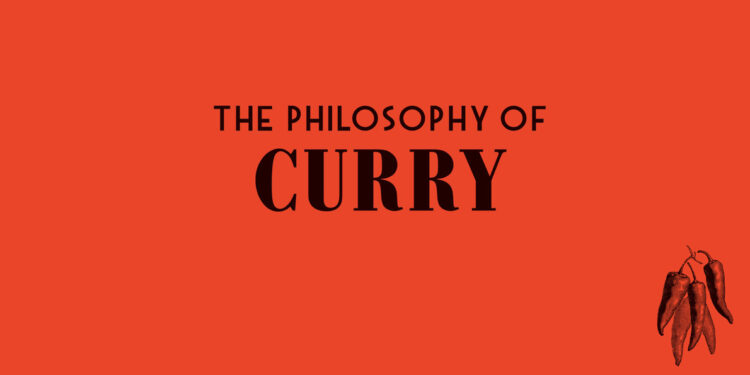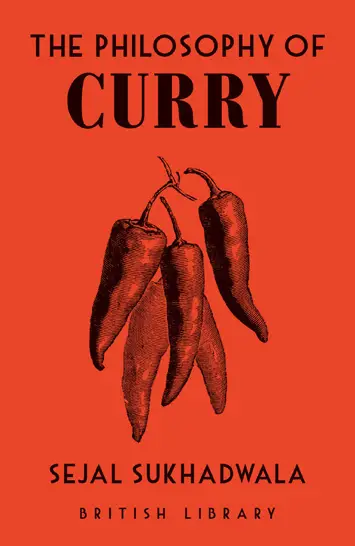The Philosophy of Curry by Sejal Sukhadwala – Review

By Clare Jenkins
During 25 years of visiting India, the only place I’ve ever been offered curry and chips was a beach-side café in Goa. Yet in Britain today, Sejal Sukhadwala tells us, ‘curry sauce… is the third most popular topping for chips after ketchup and mushy peas’.
Whoever would have thought it? Whoever would have thought, too, that curry would become a pawn in today’s cancel culture war? But that’s what happened last year, when a California-based Indian American food blogger asked her followers to stop using the term because, she said, it was rooted in British colonialism.
British-Indian food writer Sukhadwala is having none of it. She acknowledges that the word does have a colonial association, and that it can still be problematic (in some European cities, for instance, people in apartment blocks are asked not to cook curry, because of the strong, spicey smells). But India, she says, ‘has already fully embraced the term curry’. I’ve even seen it on one of the country’s rhyming roadside warning signs: ‘Hurry hurry, spoil the curry’, as drivers helter-skelter up to Darjeeling.
The thing about the word curry is that it’s reductionist, encompassing a whole host of Indian dishes: the coconut-based Kerala stew, ‘said to have been introduced in the first century AD by Syrian Christians, who learned how to make it from Irish monks’; Hyderabadi dishes, which include fresh coconut, curry leaves and tamarind; Goan meals that combine South Indian ingredients with Portuguese techniques. Then there’s chana masala, dum aloo, sag paneer, vegetable makhanwala… and that object of sit com humour, the vindaloo.
Her own definition of the word is ‘a spiced dish of Indian origin or influence, in which vegetables, or meat or other protein, are normally cooked in a pot, usually with a gravy made from tomatoes, onions, coconut, yoghurt, gram flour, nuts, cereal, water or stock. I know this definition isn’t entirely adequate, but I have tried to cover all bases’.
And cover all bases she does, in this trim (100 illustrated pages), slightly misleadingly titled book. Rather than philosophy, it explores the history, ingredients, influence, varieties, versatility, and cultural connotations of this global cuisine, which may owe its name to the Tamil word kari, before segueing over the centuries into carie and curree, and then the English word curry. ‘So the Portuguese and then the British may have turned kari or caril into curry,’ Sukhadwala concludes, ‘but they didn’t just pluck it out of thin air – the word still has Indian roots’.
Whatever its origins, curry goes back a long way – mentioned not just in ancient Indian literature, including the Sanskrit epic the Mahabharata, but also by ancient Greek historians. 16th Century Jewish settlers introduced sugar and pomegranates. The Mughals introduced Persian ingredients – rosewater, saffron, pistachios, dried fruit. It was during the time of the third Mughal emperor, Akbar (1556-1605), we learn, that this style of cooking really came into its own, with its koftas, dopiazas and kormas. In her 1880 cookbook, Raj-era writer Flora Annie Steel described korma as ‘one of the richest of Hindoostani curries… but quite unsuited to European taste’. It’s currently Britain’s No 1 favourite Indian curry.
 The Victorians generally saw a ‘craze for all things Indian – not only food, but also textiles, jewellery, ornaments, paintings and furnishings. Sauces and relishes with names like Nabob’s and Empress of India were launched’.
The Victorians generally saw a ‘craze for all things Indian – not only food, but also textiles, jewellery, ornaments, paintings and furnishings. Sauces and relishes with names like Nabob’s and Empress of India were launched’.
“Informative”
The real Empress of India, Queen Victoria, famously loved chicken curries and ordered them to be on the menu of her Isle of Wight home, Osborne House. Her grandson George V was so passionate about them that he ate them almost every lunchtime for 35 years: ‘his favourite was beefsteak with Bombay duck’.
In 2001, Robin Cook, the then British Foreign Secretary, said chicken tikka masala was now a ‘true British national dish’. That became a question in the British citizenship test, as did when Sake Dean Mahomed opened the first curry house in the UK – in Marylebone in 1810. No, I didn’t know that, either. Like Sukhadwala, I ‘find it astonishing that would-be British citizens are expected to know this kind of curry history trivia’.
In the early part of the 20th Century, lascars – Bangladeshi sailors – who wanted to stay in the UK opened so-called Indian restaurants. By the 1940s, Brick Lane had become one of the most famous curry house areas, since joined by Leicester’s ‘Golden Mile’ of Belgrave Road, Birmingham’s Balti Triangle and Manchester’s Curry Mile, among others.
‘The early décor’, she writes, ‘which remained unchanged well into the 1990s, mimicked raj-era clubs with their swirly patterned red-and-gold flock wallpaper, heavy carved wooden furniture, brightly coloured tablecloths and brass ornaments’.
Now, though, both the décor and the menu of many Indian restaurants ‘reflect a modern, confident India that’s been stepping out of its colonial shadows… The old-school curry houses are in decline or disrepair’.
Of its global reach, she describes how, in Thailand, a curry might contain frogs, snails, snakes or wild birds. In Japan, sika deer, scallops or whale. In America, evaporated milk, salted peanuts, bacon bits and Coca-Cola. In Trinidad, they’ve been immortalised in song. There’s even a Mexican-Hindu cuisine. My own Anglo-Indian cookbook includes recipes for sheep’s brain and goat’s brain curry. Thank God for vegetarianism.
As Sukhadwala concludes in her drolly informative book: ‘Those who want to cancel the word curry are already too late. Try telling a Japanese schoolboy tucking into his kari raisu or a Trinidadian street vendor selling curry-stuffed roti that the dish they love doesn’t exist. An Indian telling an Anglo-Indian that ‘our curries are more authentic than yours’ would be the height of arrogance, so let’s not get too precious about curry’.
The Philosophy of Curry by Sejal Sukhadwala is published by the British Library, £10 hardback








